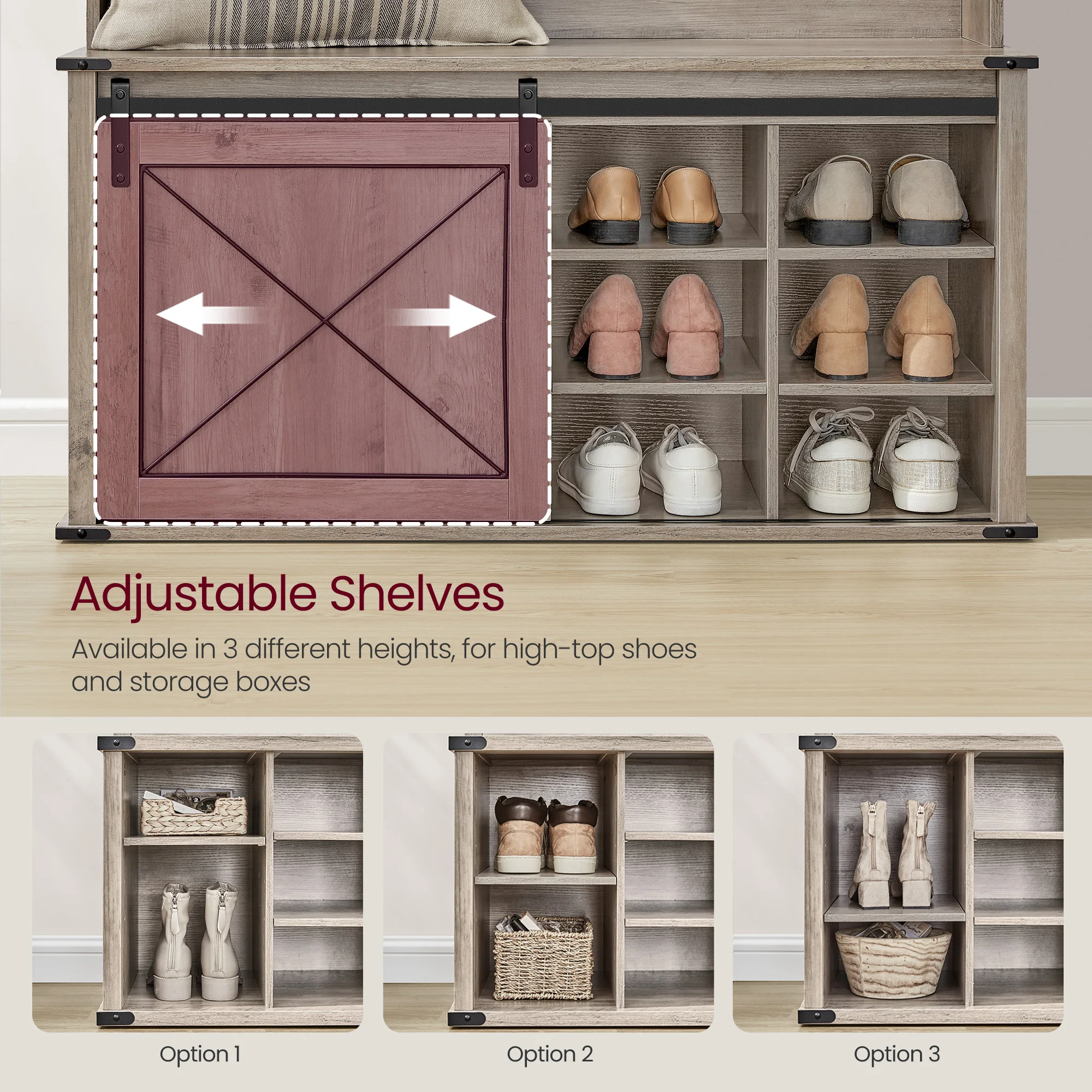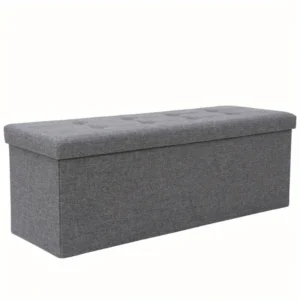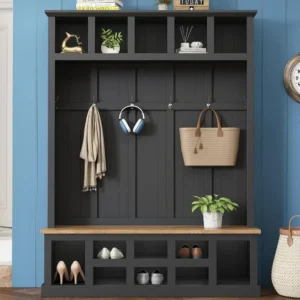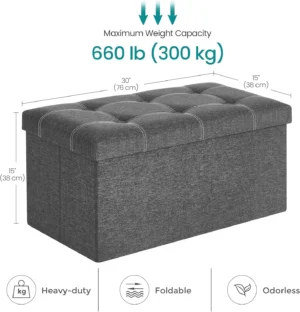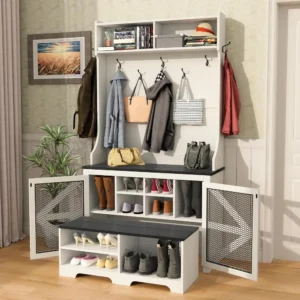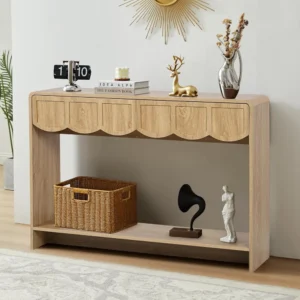Introduction: The Power of Open Shelf Entryway Furniture
Your entryway creates the first impression of your home, setting the tone for what lies beyond. Open shelf entryway furniture has gained tremendous popularity in modern home design, offering the perfect balance of style and practicality. Unlike closed cabinets, open shelving creates an airy, inviting atmosphere while providing accessible storage for everyday essentials.
The beauty of open shelving lies in its dual purpose: it serves as both a functional storage solution and a stylish display area where you can showcase your personality through carefully curated decor. Research shows that organized entryways can reduce morning stress by up to 30% and save the average person nearly 10 minutes during busy departure routines.
At Nested Goods, our philosophy of “Where Function Meets Style” is perfectly embodied in our entryway solutions. We believe that practical storage shouldn’t come at the expense of beautiful design – and open shelving exemplifies this balance perfectly.
In this article, you’ll discover:
– How to identify the perfect entryway style for your home
– Open shelving solutions for entryways of all sizes
– Clever combinations of open shelves with other entryway elements
– Tips for organizing and styling your shelves for maximum impact
The right entryway optimization strategies can transform not just your space, but your daily routine. Let’s explore how entryway bench shelf storage options and other open shelving solutions can revolutionize your home’s entrance.
Finding Your Entryway Style: Design Aesthetics for Open Shelving
Before selecting open shelving for your entryway, consider which design aesthetic resonates with your home’s overall style. The right choice will create a cohesive look that flows naturally into adjoining spaces.
Modern & Minimalist
Clean lines, uncluttered surfaces, and a neutral color palette define modern minimalist entryways. Look for open shelving with sleek profiles in materials like glass, metal, or engineered wood with matte finishes. Keep styling sparse with just a few statement pieces – perhaps a sculptural vase, a small plant, and carefully selected books. The beauty here lies in restraint and negative space.
Rustic & Farmhouse
Warm, inviting, and comfortably lived-in, rustic entryways feature natural wood with visible grain patterns, often in distressed or reclaimed finishes. Open shelving in this style might include thicker planks with decorative brackets or rough-hewn floating shelves. Style with vintage containers, woven baskets, and natural elements like pinecones or dried flowers to enhance the organic feel.
Scandinavian Simplicity
Bright, light, and functional, Scandinavian design balances beauty with practicality. Open shelving typically features pale woods like birch or ash with simple, clean designs. The color scheme centers around whites and light neutrals with occasional pops of muted color. Styling incorporates cozy textiles, simple ceramics, and thoughtful organization solutions that marry form and function.
Industrial Edge
Raw, urban, and boldly utilitarian, industrial entryways showcase metal framing, often in black or gunmetal finishes, paired with wood, concrete, or pipe elements. Open shelving might feature metal framework with wooden shelves or all-metal designs with visible hardware. Style with vintage objects, metal containers, and items with a workmanlike quality.
Bohemian Eclectic
Playful, layered, and globally inspired, bohemian entryways embrace color, pattern, and personal expression. Open shelving here is often more ornate or handcrafted, perhaps with carved details or painted finishes. Style with collected treasures, global artifacts, plants, and vibrant textiles to create a rich, storied entryway.
No matter which aesthetic speaks to you, the right entryway hall tree with open shelving can become the perfect foundation for your chosen style.
Small Space Solutions: Open Shelving for Compact Entryways
Limited square footage doesn’t mean limiting style or functionality. With strategic open shelving choices, even the tiniest entryway can become an organized, welcoming space.
Think Vertically
When floor space is at a premium, look up! Tall, narrow shelving units maximize storage capacity while maintaining a small footprint. Look for units that are 12-16 inches deep but extend several feet upward, creating ample storage without crowding the space.
Float Your Shelves
Wall-mounted floating shelves free up valuable floor space while providing essential storage. Position them at varying heights to create visual interest and accommodate items of different sizes. The absence of visible brackets creates a clean, uncluttered appearance that’s perfect for tight spaces.
Corner Conquering
Don’t overlook those often-wasted corner spaces. L-shaped open shelving units or corner-specific designs can transform awkward angles into functional storage zones. These solutions are particularly valuable in entryways with unusual layouts.
Multi-Functional Magic
In small entryways, every piece should serve multiple purposes. Look for open shelf units that incorporate seating, like a bench with shelving underneath, or hanging storage with integrated shelf space above. These combinations maximize functionality without requiring additional square footage.
Narrow Hallway Navigation
For long, narrow entryways, choose shallow depth shelving (8-10 inches deep) to maintain clear pathways. Position these sleek units strategically to avoid creating obstacles in high-traffic areas.
Implementing clever space-saving entryway ideas can make even the smallest entrance feel spacious and organized. For particularly tight spaces, consider our narrow entryway bench options that integrate seamlessly with open shelving.
Medium-Sized Entryway Inspiration: Balanced Storage Solutions
Medium-sized entryways offer more flexibility while still requiring thoughtful planning to maximize both style and function. With more space to work with, you can create distinct zones and incorporate more substantial open shelving arrangements.
Perfect Proportions
For medium entryways, look for open shelving units that are properly scaled – neither too imposing nor too diminutive. A good rule of thumb is that larger furniture pieces should occupy no more than 60% of the available wall space, leaving room for movement and additional elements.
Creating Functional Zones
- The drop zone: Open shelving near the door for immediate needs like keys and mail
- The transition zone: A bench or seating area with shoes stored on shelves below
- The display zone: Higher shelves for decorative items and less frequently used objects
- The seasonal zone: Adjustable shelving to accommodate changing weather gear
Console and Shelf Combinations
Console tables paired with open shelving above create an elegant entryway solution. The table surface provides a landing spot for daily essentials, while open shelves above display decorative objects or store less frequently used items. Look for console tables that themselves incorporate open shelving below for even more storage capacity.
Bench and Shelf Pairings
A hallmark of medium-sized entryways is the bench-shelf combination. Position a comfortable bench along one wall with carefully mounted open shelving above. This arrangement creates a natural place to sit while removing shoes, with storage for footwear below and accessories on the shelves above.
Balancing Open and Closed Storage
Medium spaces can accommodate a blend of open shelving with some closed storage options. This combination allows you to display decorative items on open shelves while concealing less attractive necessities behind cabinet doors or in decorative baskets.
These approaches to visible storage in entry furniture create organized, functional spaces that remain aesthetically pleasing and welcoming.
Statement Pieces: Open Shelving for Grand Entryways
Larger entryways offer the luxury of making bold design statements with substantial open shelving installations. These spacious areas can accommodate dramatic pieces that might overwhelm smaller spaces.
Architectural Impact
In grand entryways, consider built-in open shelving systems that become architectural features in their own right. These custom or semi-custom installations can span entire walls, creating a cohesive look that feels intentional and luxurious. Materials like solid hardwoods, marble, or specialty metals can elevate these installations to art pieces.
Dramatic Verticality
Floor-to-ceiling open bookcases create a stunning visual impact in spacious entryways. These towering units draw the eye upward, emphasizing height and grandeur. Consider versions with integrated lighting to highlight displayed objects and add ambient illumination to the space.
Space Definition
In open-concept homes where the entryway flows directly into living areas, double-sided open shelving creates effective room division without blocking light or sightlines. These substantial pieces provide storage and display space from both sides while establishing distinct zones within the larger space.
Focal Point Creation
Large entryways benefit from strong focal points that anchor the space. An oversized open shelving unit with carefully styled vignettes can serve this purpose beautifully. Position a dramatic piece on the wall opposite the entry door to create immediate visual impact upon entering.
Custom Configurations
With ample space to work with, consider custom combinations of open and closed storage elements. These bespoke solutions can perfectly address your specific storage needs while maintaining a cohesive, designer look throughout the entryway.
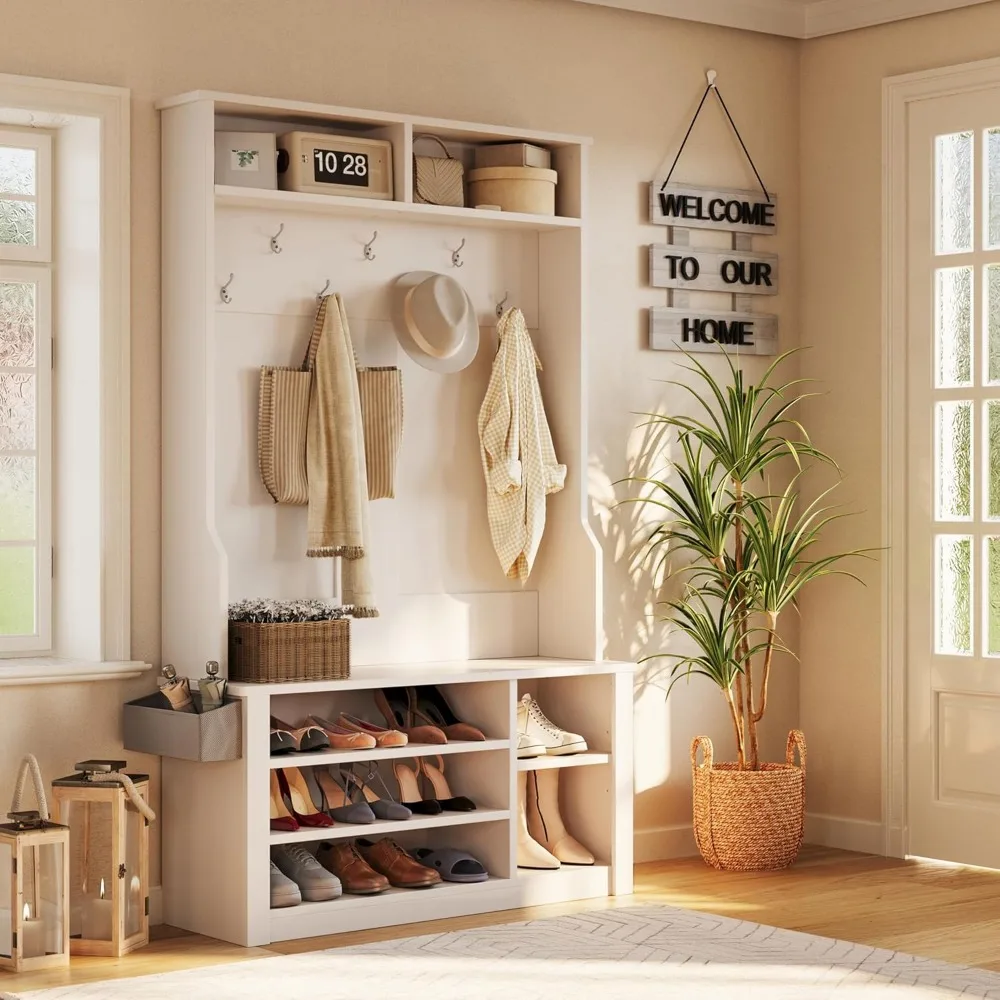
The Perfect Pairing: Open Shelves with Complementary Entryway Elements
Open shelving rarely stands alone in a well-designed entryway. The most functional and stylish entrances combine open shelves with complementary elements to create comprehensive solutions.
Open Shelves with Benches
The classic sit-and-store combination pairs open shelving above or beside a comfortable bench. This arrangement creates a natural place to sit while removing shoes, with the bench itself often incorporating additional open storage underneath. The ideal height relationship places the lowest shelf approximately 15-18 inches above the bench surface, allowing comfortable seating without crowding.
Open Shelves with Hooks
Creating a complete organization station becomes simple when you pair open shelving with strategically placed hooks. Position hooks at eye level (approximately 60-65 inches from the floor) with open shelves above and/or below. This combination accommodates coats, bags, and accessories while providing display space and storage for smaller items on the shelves.
Open Shelves with Mirrors
Brightening your entryway while adding functionality, the shelf-mirror pairing serves both practical and aesthetic purposes. Position a decorative mirror with open shelving beside or below it to create a quick grooming station where you can check your appearance while keeping essentials like keys and sunglasses within easy reach.
Open Shelves with Console Tables
Establishing effective drop zones becomes seamless when pairing a console table with open shelving. The table surface provides immediate landing space for mail, keys, and bags, while open shelving above or below organizes less frequently used items and decorative elements. For optimal function, maintain approximately 10-12 inches of clearance between the tabletop and the lowest shelf.
Integrated Lighting Solutions
Enhance the impact of your open shelving with thoughtful lighting. Options include:
– Recessed downlights that illuminate shelf surfaces
– LED strip lighting mounted underneath shelves to create ambient glow
– Picture lights that highlight specific displayed objects
– Sconces positioned beside shelving units to provide general illumination
Our bench hooks and storage solutions offer perfect complementary elements to open shelving, creating cohesive entryway systems.
Material Matters: Choosing Durable and Stylish Shelf Materials
The materials you select for your open shelving not only determine its appearance but also its durability and maintenance requirements. Choose wisely based on your aesthetic preferences and practical needs.
Solid Wood Options
| Wood Type | Characteristics | Best For |
|---|---|---|
| Oak | Highly durable, prominent grain, resists dents | High-traffic areas, traditional styles |
| Walnut | Rich color, elegant grain, naturally resistant to warping | Upscale designs, contemporary spaces |
| Maple | Smooth grain, takes paint well, highly durable | Versatile applications, painted finishes |
| Pine | Affordable, light color, rustic appearance | Farmhouse styles, budget-friendly options |
Solid wood shelving offers timeless appeal and exceptional durability when properly sealed and maintained. Each wood species brings its own character through grain patterns, color variations, and aging properties.
Metal Shelving
Metal shelving introduces industrial character and unmatched structural strength to entryway designs. Steel options provide maximum durability for heavy items, while aluminum offers lightweight alternatives for wall-mounted applications. Consider powder-coated finishes for enhanced durability and color options beyond natural metal tones.
Mixed Media Combinations
Some of the most striking open shelving designs combine materials for both visual interest and practical benefits. Wood shelves supported by metal brackets blend warmth with industrial edge. Glass shelves in metal frames create airy, light-reflective solutions ideal for smaller spaces. These combinations allow you to introduce multiple textures into your entryway design.
Glass Shelving Options
For contemporary spaces or areas where visual lightness is desired, glass shelving offers elegant solutions. Tempered glass provides necessary safety and durability, while options like frosted, seeded, or tinted glass add decorative elements. Glass shelves create the illusion of more space by allowing light to pass through but require more frequent cleaning to maintain their pristine appearance.
Sustainable Alternatives
Eco-conscious homeowners can explore sustainable shelving materials like bamboo (rapidly renewable), reclaimed wood (zero new harvest), or composite materials made from recycled content. These options reduce environmental impact while often introducing unique character through their origin stories and distinctive appearances.
Our best small benches for entryways guide offers additional insights on material selection for coordinated entryway furniture pieces.
Organization Mastery: Keeping Open Shelves Functional and Beautiful
The beauty of open shelving lies in its visibility – but this transparency also demands thoughtful organization to prevent a cluttered appearance. Master these strategies to maintain both function and style.
The Display-Storage Balance
The most successful open shelving strikes a perfect balance between practical storage and aesthetic display. A good rule of thumb is the 70/30 principle: dedicate approximately 70% of your shelf space to essential storage and 30% to purely decorative items. This ratio ensures your entryway remains functional while still offering visual interest.
Decorative Containment
Transform necessary storage into design elements by selecting containers that enhance rather than detract from your space. Consider:
– Woven baskets in natural materials for a warm, textural element
– Decorative boxes with interesting patterns or materials for small items
– Matching glass or ceramic containers for a cohesive, streamlined look
– Vintage vessels or unique containers that become conversation pieces
Organization Principles
Apply these foundational organizing principles to create visually pleasing shelf arrangements:
– Group similar items together (books with books, containers with containers)
– Create color cohesion through intentional palette choices
– Arrange items by height, typically with taller items at the back or sides
– Maintain a consistent level of “density” across shelves to avoid visual imbalance
Seasonal Rotation Strategy
Prevent entryway clutter by implementing a seasonal rotation system. Store off-season gear elsewhere, bringing items into the entryway only when needed. Dedicate one shelf or container specifically for seasonal transitions – holding winter accessories in cold months or summer essentials during warmer periods.
The Power of Negative Space
Perhaps the most overlooked aspect of beautiful open shelving is what you don’t put on it. Intentional empty space creates visual breathing room and prevents a cluttered appearance. Aim to leave approximately 20-30% of each shelf empty or sparsely decorated, allowing individual items to stand out rather than compete for attention.
Our shoe storage bench collection offers additional solutions that complement open shelving while keeping footwear neatly contained and accessible.
Styling Your Open Shelves: Creating Visual Impact in Your Entryway
Transform functional open shelving into a design statement with these expert styling techniques that balance practicality with visual appeal.
Creating Depth Through Layering
Move beyond flat, one-dimensional arrangements by thoughtfully layering items:
– Position larger items or artwork at the back
– Place medium-sized objects in the middle ground
– Add smaller accents at the front
– Occasionally allow items to slightly overlap for a curated rather than staged look
The Rule of Odd Numbers
Professional stylists rely on this simple trick: grouping items in odd numbers (typically threes or fives) creates more visually interesting arrangements than even-numbered groupings. This approach creates asymmetry that draws the eye and appears intentionally designed rather than randomly placed.
Incorporating Personal Elements
The most inviting entryways include personal touches that tell your home’s story:
– Family photographs in coordinated frames
– Souvenirs or mementos from significant trips
– Heirloom objects with sentimental value
– Artwork created by family members
– Books that reflect your interests and passions
Adding Texture Through Mixed Materials
Create rich, layered vignettes by combining textures:
– Contrast smooth surfaces (glass, polished metal) with rough textures (woven baskets, raw ceramics)
– Include natural elements like wood, stone, or plants
– Mix soft textiles with hard surfaces
– Incorporate items with visual texture through patterns or finishes
Color Theory Basics
Apply these color principles for cohesive shelf styling:
– Choose a primary color scheme with 3-5 colors that complement your overall decor
– Use the 60-30-10 rule: 60% dominant color, 30% secondary color, 10% accent color
– Create visual flow by repeating colors across different shelves
– Consider the color weight – balance lighter and darker elements throughout the arrangement
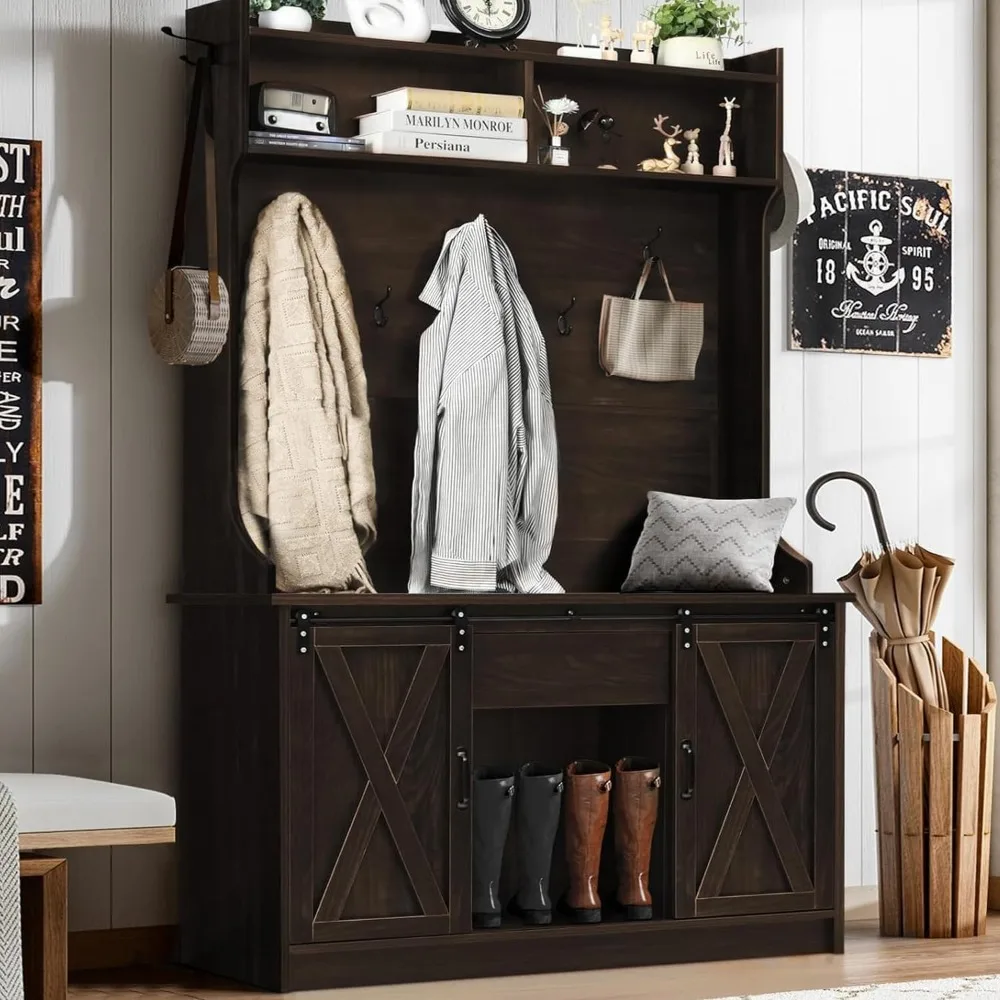
The principles of open and closed shelving in entryway design can help you create the perfect balance in your home’s entrance.
DIY Customization: Making Standard Open Shelving Uniquely Yours
Transform basic open shelving into custom pieces that reflect your personal style with these simple yet effective modifications.
Hardware Transformations
Swapping standard shelf brackets or hardware for specialty alternatives instantly elevates basic shelving. Consider antique brass brackets for traditional homes, sleek black hardware for modern spaces, or decorative scrollwork for romantic aesthetics. This simple change requires only basic tools but dramatically alters the overall impression.
Paint Techniques for Personality
Beyond basic solid colors, explore these painting approaches:
– Ombré gradients that transition from light to dark
– Two-tone effects with contrasting edges or undersides
– Stenciled patterns on shelf faces
– Distressed or antiqued finishes for character
– Color-blocked sections for modern appeal
Backing Material Additions
Add visual interest to open shelves by installing backing materials that create contrast and depth:
– Patterned wallpaper for unexpected color and texture
– Beadboard for cottage or farmhouse charm
– Mirror panels to reflect light and create the illusion of space
– Reclaimed wood for rustic character
– Textured grasscloth for natural warmth
Edge Treatments and Details
The edges of your shelving offer another opportunity for customization:
– Add decorative molding to shelf fronts
– Incorporate routed edge details for architectural interest
– Apply metal edge banding for industrial flair
– Create bullnose or rounded edges for a softer look
– Add leather or fabric wrapping for unique texture
Personal Embellishments
Make shelving truly one-of-a-kind with personal touches:
– Decoupage favorite images or maps onto shelf surfaces
– Attach decorative hardware like vintage knobs as hooks or accents
– Apply gold leaf for glamorous metallic details
– Incorporate mosaic tile work along edges or surfaces
– Add stained glass elements for colorful light play
Our entryway coat rack bench collection offers excellent foundations for customization projects that combine open shelving with additional functionality.
Expert Installation: Getting Open Shelf Entryway Furniture Right
Proper installation ensures your open shelving is both beautiful and safe. Address these common concerns before mounting your entryway storage solution.
Weight Considerations and Support
How much weight can your shelving safely hold? Standard floating shelves typically support 25-35 pounds per linear foot when properly mounted to wall studs. For heavier items, choose shelving with visible brackets or supports, which can increase capacity to 75+ pounds per linear foot. Always check manufacturer specifications for exact weight limits.
Finding Studs and Using Proper Anchors
Locating wall studs is essential for secure shelf installation. Use an electronic stud finder or the traditional knocking method to locate these solid mounting points. When studs aren’t available, use appropriate wall anchors based on your wall type:
– Drywall: Toggle bolts or molly bolts for heavier loads
– Plaster: Specialized plaster anchors that expand behind the wall
– Concrete or brick: Masonry anchors with pre-drilled holes
– Paneling: Through-bolts that penetrate to structural elements behind
Height and Accessibility Guidelines
Position shelving at heights appropriate for your family’s needs:
– Lower shelves (30-48 inches from the floor) for frequently accessed items
– Mid-height shelves (48-60 inches) for regularly used items
– Upper shelves (60-72 inches) for seasonal or decorative items
– Allow 10-12 inches of vertical clearance between shelves for average-height items
– Consider the height of family members when determining optimal placement
Inclusive Design Considerations
For universal accessibility, incorporate these ADA-informed guidelines:
– Position essential storage between 15 and 48 inches from the floor
– Ensure clear floor space (30 x 48 inches minimum) in front of shelving
– Provide some storage accessible from a seated position
– Consider pull-down or adjustable shelving systems for varying height needs
– Use high-contrast colors to distinguish shelf edges for those with visual impairments
Avoiding Common Installation Mistakes
Prevent these frequent installation errors:
– Uneven shelving (use levels during installation)
– Inadequate support for the intended weight
– Improper spacing that limits usability
– Mounting too close to door swings or walkways
– Installing at heights inappropriate for the primary users
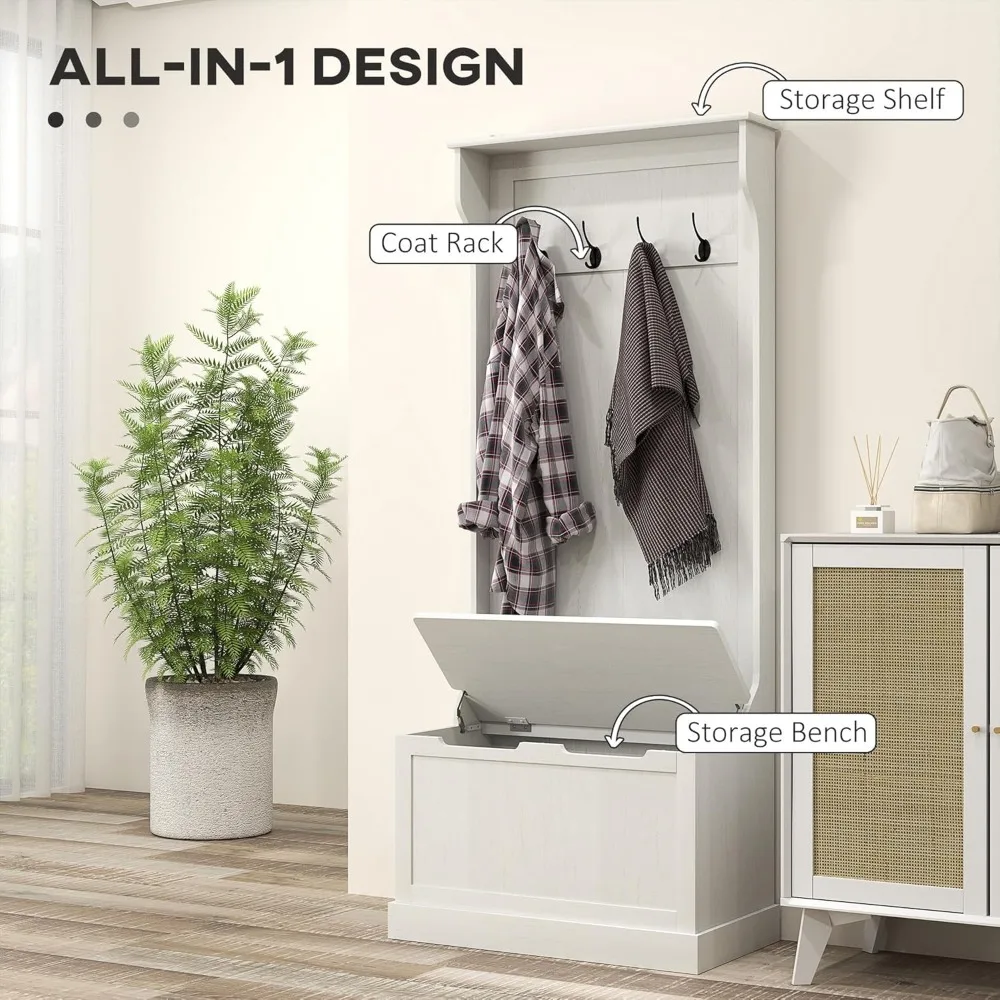
30 Inspiring Open Shelf Entryway Ideas: A Visual Gallery
- Floating oak shelves paired with minimalist iron hooks for a Scandinavian-inspired welcome
- Industrial pipe shelving with reclaimed wood planks above a simple bench
- Asymmetrical geometric shelving in white lacquer for modern entryways
- Built-in nook shelving that utilizes an otherwise awkward corner
- Glass shelves with brass brackets for an elegant, light-reflecting solution
- Rustic timber floating shelves against shiplap for farmhouse charm
- Curved corner shelving that softens angular entryways
- Alternating shelf depths creating a stepped display opportunity
- Wall-to-wall built-in shelving with integrated bench seating
- Shadow box style shelving with defined compartments for organized storage
Entryway Bench with Shelf Storage, Shoe Bench for Entryway, Shoe Storage Bench
$194.08 Select options This product has multiple variants. The options may be chosen on the product pageBench with Hooks and Storage, Entryway Hall Tree, Mudroom Bench with Cubbies, Mudroom Bench with Shoe Storage
$818.38 Select options This product has multiple variants. The options may be chosen on the product pageEntryway Coat Rack Bench, Entryway Hall Tree, Farmhouse Mudroom Bench, Mudroom Bench with Shoe Storage
$805.09 Select options This product has multiple variants. The options may be chosen on the product pageEntryway Bench with Shelf Storage, Small Shoe Bench
$151.16 Select options This product has multiple variants. The options may be chosen on the product pageBench with Hooks and Storage, Entryway Coat Rack Bench, Entryway Hall Tree, Mudroom Bench with Shoe Storage, Mudroom Coat Rack Bench
$793.73 Select options This product has multiple variants. The options may be chosen on the product page- Price range: $785.40 through $897.63 Select options This product has multiple variants. The options may be chosen on the product page
- Ladder-style leaning shelves requiring no wall mounting
- Suspended shelving hanging from ceiling for unique visual interest
- Hexagonal modular shelving creating a honeycomb pattern
- Slim depth shelving perfect for narrow hallway entryways
- Two-tone shelving with dark brackets and light wood for contrast
- Floor-to-ceiling built-in shelving flanking a central mirror
- Floating corner shelves maximizing awkward angular spaces
- Metal grid shelving with removable wood trays for flexibility
- Live-edge wood slabs as natural, organic floating shelves
Backlit shelving with LED strips for ambient entrance lighting
Window-adjacent shelving positioned to display sun-catching objects
- Symmetrical twin shelving units flanking a central console
- Picture ledge-style shallow shelving for photo and art display
- Cubby-style open shelving with integrated labeled baskets
- Slim vertical shelving tower for extremely narrow spaces
- Double-sided open bookcase as room divider in open-concept entryways
- Under-staircase triangular shelving utilizing often-wasted space
- Adjustable track shelving allowing for changing storage needs
- Circular floating shelves creating a modern geometric display
- Integrated shelving and seating built into a bay window nook
Our small entryway bench organization techniques can help you maximize these inspiration ideas in your own home.
Frequently Asked Questions: Open Shelf Entryway Furniture
How do I keep open shelving from collecting dust?
Regular maintenance is key – aim for weekly dusting using microfiber cloths or dusters with extendable handles for higher shelves. For preventative measures, consider applying furniture wax to wooden shelves, which creates a slightly smoother surface that collects less dust. For delicate items on display, glass domes or cloches can provide protection while maintaining visibility.
What items should I avoid displaying on open entryway shelves?
Avoid placing valuable documents, electronics sensitive to temperature fluctuations, or heirlooms that could be damaged by sunlight on open shelving. Similarly, highly personal items or valuables that might attract unwanted attention through windows should be stored elsewhere. Fragile items should be placed away from edges and secured with museum putty in homes with children or pets.
How much weight can typical floating shelves support?
Weight capacity varies significantly based on construction and installation. Standard floating shelves properly installed into studs typically support 25-35 pounds per linear foot. Specialized heavy-duty floating hardware can increase this to 50+ pounds per linear foot. Visible bracket supports substantially increase capacity, often allowing 75-100 pounds per linear foot when properly mounted.
Can open shelving work in homes with young children or pets?
Yes, with thoughtful planning! Position breakable or valuable items on higher shelves beyond reach. Use the lower shelves for child-friendly storage like baskets containing toys or pet supplies. Consider adding subtle lips or guards to shelf edges to prevent items from being easily knocked off. Select sturdy, well-anchored shelving units that won’t tip if accidentally pulled or climbed upon.
What’s the ideal height for mounting entryway shelves?
For maximum accessibility, position your primary functional shelving between 48-64 inches from the floor – this range works well for average adult height. Lower shelves (30-48 inches) work perfectly for children’s items or frequently used objects. Decorative shelving can be positioned higher, up to 72 inches. Allow 10-12 inches of vertical clearance between shelves for standard items, more for taller objects.
Our entryway bench storage solutions complement open shelving to create complete organization systems for homes of all sizes.
Seasonal Adaptations: Refreshing Your Entryway Open Shelving Throughout the Year
One of the greatest advantages of open shelving is its adaptability – with minimal effort, you can transform your entryway’s appearance and functionality to match changing seasons.
Spring Refresh
Embrace renewal with botanical elements and lighter accessories:
– Replace heavy winter bins with lighter woven baskets
– Incorporate fresh flowers or potted plants for living color
– Swap dark textiles for lighter, brighter alternatives
– Display nature-inspired decor like bird’s nests or botanical prints
– Introduce pastel accents that reflect the season’s softer palette
Summer Styling
Create an airy, vacation-inspired welcome:
– Display beach finds like shells or sea glass in glass containers
– Incorporate natural materials like jute, raffia, and light woods
– Add vibrant pops of color through small accessories or artwork
– Position a small bowl for sunglasses and sun protection essentials
– Include a water-resistant basket for pool or beach necessities
Fall Transitions
Add warmth and texture as temperatures cool:
– Introduce amber glass containers and copper or brass accents
– Display miniature pumpkins or gourds for seasonal charm
– Include baskets for gloves and light scarves
– Add warm-toned textiles like small throw blankets
– Incorporate natural elements like pinecones or preserved leaves
Winter Adaptations
Maintain organization during the season of heavy gear:
– Add extra baskets or bins for hats, gloves, and scarves
– Incorporate strategic hooks under shelves for hanging items
– Display battery-operated candles for warm, safe illumination
– Include seasonal greenery like small evergreen arrangements
– Position a tray or bowl for hand warmers and winter car essentials
Holiday Decorating
Maintain organization while embracing festive touches:
– Add string lights to outline shelf edges for subtle illumination
– Display small holiday-specific decor items among everyday essentials
– Use seasonal containers that incorporate holiday colors or patterns
– Include a dedicated spot for incoming holiday cards or invitations
– Maintain at least 70% functional storage to handle increased holiday traffic
By thoughtfully adapting your open shelving through seasonal changes, you create an entryway that remains both beautiful and functional year-round, always ready to welcome guests and serve your family’s changing needs.

